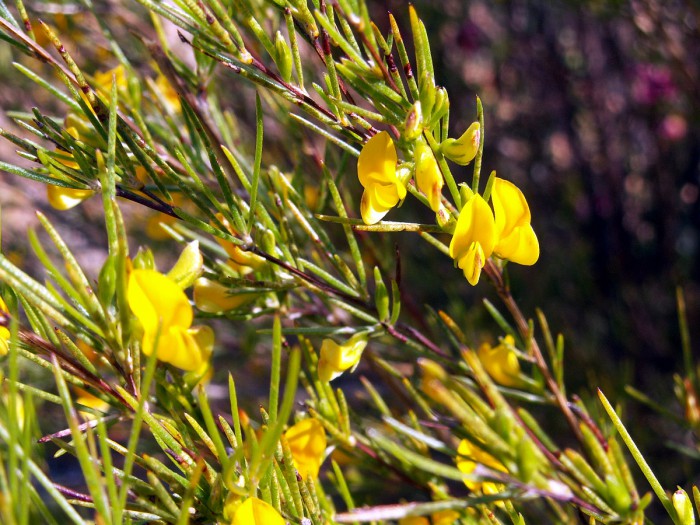Dies ist eine alte Version des Dokuments!
Aspalathus linearis (N.L.Burm.) R.Dahlgr. - Fabaceae - rooibostee, bossietee (afr.), rooibos, Rooibos
Erect to spreading, much-banched shrub or subshrub, up to 2m high, native to the western parts of the Western Cape Province in South Africa; stems reddish-brown; leaves dark green, needle-shaped, 1.5-6cm long; flowers yellow, solitary or arranged in dense groups at the tips of branches; fruit a small lance-shaped pod with 1-2 seeds. Cutted and fermented leaves and twigs are used to make healthy beverage, the infusion is also used as antispasmodic.
„The tea cuttings are chopped very fine and then bruised to ensure that the important chemical reaction which develops the characteristic colour and flavour of the tea can take place. After watering and airing, the tea is left to „sweat“ in heaps and it at this point that the tea acquires its typical reddish brown colour and develops its sweet flavour. After the sweating process has been completed, it is spread out in a large drying yard to dry in the sun.“ http://plantzafrica.com/plantab/aspallinearis.htm
„The main medicinal use of rooibos tea is as a milk substitute for babies who are prone to cholic.“
[Medicinal Plants of the World. Ben-Erik Van Wyk and Michael Wink, Pretoria 2004, 59]
The high-impact chemical 3-sulfanylhexan-1-ol, with its unique scent of grapefruit and tropical fruits, is also an important trace constituent of 'red tea' (rooibos tea).
[Meaningful Scents around the World, R.Kaiser, 2006, 69]
„Most of the individual flavonoids and other phytochemical constituents of rooibos and honeybush are found either exclusively in one or the other plant, i.e. flavan-3-ols, flavones, dihydrochalcones, proanthocyanadins and phenolic acids are predominantly found in rooibos while isoflavones, coumestans, inositols and xanthones predominate in honeybush. Eriodictyol and luteolin are the only individual components identified to date that are common to both plants.“
[A review of the bioactivity of South African herbal teas: rooibos (Aspalathus linearis) and honeybush (Cyclopia intermedia). McKay, Diane L., and Jeffrey B. Blumberg., Phytotherapy Research Vol.21(1), 2007, 1-16]
„Used as a herbal beverage by the indigenous Khoi people since the late 1700s… Aside from
the tea after infusing creating a deep natural red color with a full flavor and body, this herbal tea is caffeine free, has a low tannin content - estimated at 3% in the leaves, is high in antioxidant activity…
previously 99 and 218 volatile components were reported in the vacuum steam distillate and headspace vapor of traditional rooibos… guaiacol (24%), 6-methyl-3,5-heptadien-2 one isomer (5.2%), damascenone (5%), geranylacetone (4.2%), β-phenylethyl alcohol (4.1%) and 6-methyl-5-hepten-2-one (4%) comprises the major volatile components.“
[Marnewick, Jeanine L. „Rooibos and honeybush: recent advances in chemistry, biological activity and pharmacognosy.“ African Natural Plant Products: New Discoveries and Challenges in Chemistry and Quality. ACS Symposium Series. Vol. 1021. 2009]
http://port-trading.com/wp-content/uploads/2010/08/newsletter1.pdf

Aspalathus linearis (N.L.Burm.) R.Dahlgr., Clanwilliam, Westkap, Südafrika
CC BY-SA 2.5, Author: Amrum Wikimedia Commons
